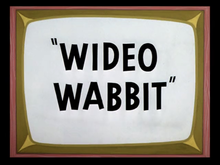
Bugs Bunny is a fictional character created in the late 1930s at Warner Bros. Cartoons and voiced originally by Mel Blanc. Bugs is best known for his featured roles in the Looney Tunes and Merrie Melodies series of animated short films, produced by Warner Bros. Earlier iterations of the character first appeared in Ben Hardaway's Porky's Hare Hunt (1938) and subsequent shorts before Bugs's definitive characterization debuted in Tex Avery's A Wild Hare (1940). Bob Givens, Chuck Jones, and Robert McKimson are credited for defining Bugs's design.

Daffy Duck is a fictional character created by animators Tex Avery and Bob Clampett for Leon Schlesinger Productions. Styled as an anthropomorphic black duck, he has appeared in cartoon series such as Looney Tunes and Merrie Melodies, in which he is usually depicted as a foil for either Bugs Bunny, Porky Pig or Speedy Gonzales. He was one of the first of the new "screwball" characters that emerged in the late 1930s to replace traditional everyman characters who were more popular earlier in the decade, such as Mickey Mouse, Porky Pig, and Popeye.

What's Opera, Doc? is a 1957 American Warner Bros. Merrie Melodies cartoon directed by Chuck Jones and written by Michael Maltese. The short was released on July 6, 1957, and stars Bugs Bunny and Elmer Fudd.

The Big Snooze is a 1946 Warner Bros. Looney Tunes cartoon planned by Bob Clampett and was written by him, but was ultimately completed by Arthur Davis, both being uncredited as directors. Its title was inspired by the 1939 book The Big Sleep, and its 1946 film adaptation, also a Warner release. The Big Snooze features Bugs Bunny and Elmer Fudd, voiced by Mel Blanc and Arthur Q. Bryan.

Hare Brush is a 1955 Warner Bros. Merrie Melodies animated short directed by Friz Freleng. The short was released on May 7, 1955, and stars Bugs Bunny and Elmer Fudd.
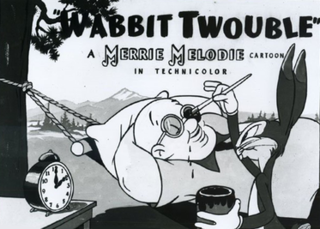
Wabbit Twouble is a Merrie Melodies cartoon starring Bugs Bunny, produced by Leon Schlesinger Productions and released on December 20, 1941 by Warner Bros. Pictures. This is the first of several Bugs Bunny cartoon titles that refer to Elmer Fudd's speech impediment, with the names of Bob Clampett, Sidney Sutherland, and Carl Stalling, as well as the roles of Story, Supervision, and Musical Direction, intentionally misspelled in the credits to match the speech impediment.
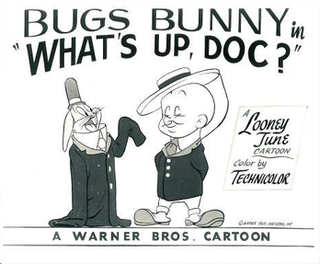
What's Up, Doc? is a Looney Tunes cartoon film directed by Robert McKimson and produced by Warner Bros. Cartoons. It was released by Warner Bros. Pictures in 1950 to celebrate Bugs Bunny's 10th birthday that year, in which he recounts his life story to a reporter from the "Disassociated Press". Bugs talks about his birth, his rise to fame, the slow years, and how famous Vaudeville performer Elmer Fudd chooses him to be part of his act. Eventually the duo comes upon their classic formula of Hunter vs. Hare. The short also was the first to use the title card music which would continue to be used in Bugs Bunny's cartoons and in most modern Looney Tunes series. Arthur Q. Bryan, Dave Barry and The Sportsmen Quartet performed voice works but were not credited.

Rabbit Seasoning is a 1952 Warner Bros. Merrie Melodies cartoon directed by Chuck Jones. Released on September 20, 1952, the short stars Bugs Bunny, Daffy Duck and Elmer Fudd.

Looney Tunes Golden Collection: Volume 1 is a DVD box set that was released by Warner Home Video on October 28, 2003. The first release of the Looney Tunes Golden Collection DVD series, it contains 56 Looney Tunes and Merrie Melodies cartoons and numerous supplements. The set won the Classic Award at the Parents' Choice Awards.

The Old Grey Hare is a 1944 Merrie Melodies cartoon directed by Bob Clampett. The short was released on October 28, 1944, and features Bugs Bunny and Elmer Fudd.

Slick Hare is a 1947 Merrie Melodies cartoon, directed by Friz Freleng. The film was released on November 1, 1947, and features Bugs Bunny and Elmer Fudd. It parodies the Mocambo nightclub in Los Angeles—in the cartoon referred to as "The Mocrumbo". Mel Blanc voices Bugs, Arthur Q. Bryan voices Elmer Fudd and impressionist Dave Barry portrays Humphrey Bogart. The title is a pun on "hair", from an era when hair slicked down by oil was a popular fashion style for men.

Hare Tonic is a 1945 Warner Bros. cartoon in the Looney Tunes series, directed by Chuck Jones and written by Tedd Pierce. It stars Bugs Bunny and Elmer Fudd, making this the second cartoon directed by Jones to co-star the two. Voice characterizations are by Mel Blanc and Arthur Q. Bryan.

Easter Yeggs is a 1947 Looney Tunes theatrical animated short. The cartoon was released on June 28, 1947, and features Bugs Bunny and Elmer Fudd. The title is a play on "Easter eggs" and on "yegg", a slang term for a burglar or safecracker.
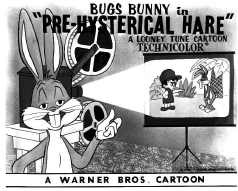
Pre-Hysterical Hare is a 1958 Warner Bros. Looney Tunes cartoon directed by Robert McKimson and written by Tedd Pierce. The short was released on November 1, 1958, and stars Bugs Bunny and Elmer Fudd. The two are in their usual hunter-and-bunny antics, but set in the Stone Age.
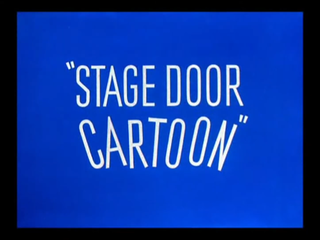
Stage Door Cartoon is a 1944 Merrie Melodies cartoon directed by Friz Freleng. The short was released on December 30, 1944, and features Bugs Bunny and Elmer Fudd.

Elmer J. Fudd is an animated cartoon character in the Warner Bros. Looney Tunes/Merrie Melodies series and the archenemy of Bugs Bunny. His aim is to hunt Bugs, but he usually ends up seriously injuring himself and other antagonizing characters. He speaks in an unusual way, replacing his Rs and Ls with Ws, so he often refers to Bugs Bunny as a "scwewy" or "wascawwy (rascally) wabbit". Elmer's signature catchphrase is, "Shhh. Be vewy vewy quiet, I'm hunting wabbits", as well as his trademark laughter.
The character that would evolve into Bugs Bunny appeared in four cartoon shorts before his first official appearance in Tex Avery's A Wild Hare. While this early version is commonly referred to as "Happy Rabbit", animation historian David Gerstein disputes this, saying that the only usage of the term was from Mel Blanc himself; the name "Bugs Bunny" was used as early as April 1938, from a model sheet made by Charles Thorson which was used for the short Hare-um Scare-um. Bugs was also mentioned by name from an August 1939 review of the short in the Motion Picture Herald.

New Looney Tunes is an American animated television series from Warner Bros. Animation based on the characters from Looney Tunes and Merrie Melodies. The series debuted on September 21, 2015, on Cartoon Network, and continued with new episodes beginning on October 5, 2015, on Boomerang. Part way through the first season, new episodes would premiere on Boomerang's video on demand service before airing on television.
